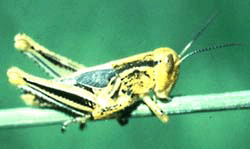Description
Grasshopper damage occurs most frequently in areas with less than 25-30 inches annual rainfall. Grasshopper populations fluctuate in cycles. High or very high populations may be present for two to four years followed by low to moderate populations for several years. Even when overall populations are relatively low, grasshoppers in and around the garden can be a nuisance. In outbreak years, grasshoppers can destroy unprotected gardens and threaten small trees and shrubs.
Weedy, untilled areas, such as vacant lots, ditches and poor pastures with mixed grass and broadleaf plants serve as the preferred egg laying and early season feeding areas for grasshoppers. Dense grass growth or regular tillage of these areas will reduce grasshopper numbers.
Over 100 grasshopper species occur in Nebraska; however, only four grasshopper species - the migratory, differential, twostriped, and redlegged - cause most damage in yards and gardens. The potential for grasshopper damage increases as summer progresses. Adults will be more likely to move into yards and gardens in July and August. Severe problems may arise when adjacent agricultural crops or grasslands mature or are harvested and grasshoppers move to find new food sources. Defoliation is the primary injury to plants, but fruit and ripening kernels of grain also will serve as food sources.
Grasshoppers often damage yard and garden plants by defoliation. They show a preference for flowers and some garden vegetables (e.g. lettuce, beans, sweet corn), but when populations are high they will feed on nearly all garden vegetables, as well as trees and shrubs. Defoliation of larger trees will have limited impact unless this defoliation continues for more than one year. Small trees and shrubs will be the most seriously affected.
Grasshopper management can be effective if the area to be protected is relatively small and isolated. High value plants in the vegetable garden or landscape can be protected by constructing a physical barrier with row covers or aluminum window screen. Make sure to include a cap, to prevent grasshoppers from climbing over the barrier. Fabric screen is not effective as a barrier, since grasshoppers can easily chew through it. Protecting a large garden from grasshoppers moving out of a large area of adjacent grassland or cropland may be impossible.
Chemical control of grasshoppers is most effective when they are ½ - ¾ inches long. At this stage, grasshoppers are concentrated in their hatching areas, and can be controlled more effectively than when dispersed later in the summer. Many insecticides are available for use in the lawn and garden, including Sevin (carbaryl), Eight (permethrin) and malathion. Repeat applications will be necessary for continued control. Read and follow all directions and precautions on the insecticide label. Treat hatching areas, as well as the yard or garden, to kill young grasshoppers. This includes ditches, and tall grassy or weedy areas surrounding the landscape.
Additional management strategies that can be used in the landscape to mitigate grasshopper damage include the following:
- Irrigation can be used to keep vegetation in surrounding areas green so grasshoppers will not move into the garden as readily.
- Leaving border areas unmowed will delay grasshopper movement into the yard and garden. Tall grass provides food and shelter for the grasshoppers.
- A trap crop of attractive plants (e.g. zinnias or some other lush flower or vegetation) can be planted around the edge of the garden to attract and hold grasshoppers. Also, these areas can be sprayed to reduce populations.
Management

